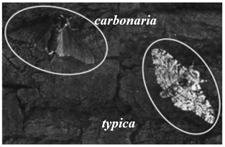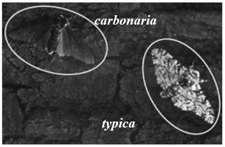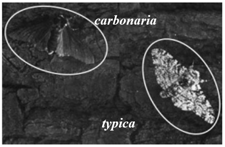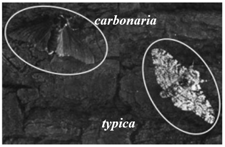Theories of Evolution
Theories of Evolution: Overview
The topic assists us with the theories of evolution in detail. It describes Lamarck's theory of inheritance of acquired characters. Furthermore, the theory of vestigial organs is also described here.
Important Questions on Theories of Evolution
"The ‘fitness’ of a population helps in evolution." The statement was given by:
In the early part of the 19th century the common form of Biston betularia, called typica, had a peppered appearance. Its wings were flecked with black and white, and it was well camouflaged in its favourite resting place , the pale and lichen covered barks of trees in rural England. A dark or melanistic form of the moth, called, carbonaria, was first recorded in about 1848, and presumably had existed in very small numbers before them, but by the middle of 20th century, the melanistic form of the moth had come to represent over 95% of the Biston betularia population, especially in such industrial centres as Manchester and Liverpool. This is among the most rapid of all recorded evolutionary changes. Why was there such a dramatic change in fortune of the peppered typica and the melanistic carbonaria? With rapid industrialisation, soot came to cover the barks of trees, making them black instead of pale, and also killed the lichens. Now the melanistic form was better camouflaged on the darkened bark, while the peppered form became increasingly less camouflaged and hence more easily detected and eaten by birds. The birds, which had kept the melanistic form at a very low frequency before industrialisation, now concentrated their attention on the peppered-form. Natural selection, in the form of bird predation, favoured the peppered form earlier and the melanistic form later.
- Excert from survival strategies by Raghavendra gadagkar.
Select the option that correctly summarises the given observation in the passage.
In the early part of the 19th century the common form of Biston betularia, called typica, had a peppered appearance. Its wings were flecked with black and white, and it was well camouflaged in its favourite resting place , the pale and lichen covered barks of trees in rural England. A dark or melanistic form of the moth, called, carbonaria, was first recorded in about 1848, and presumably had existed in very small numbers before them, but by the middle of 20th century, the melanistic form of the moth had come to represent over 95% of the Biston betularia population, especially in such industrial centres as Manchester and Liverpool. This is among the most rapid of all recorded evolutionary changes. Why was there such a dramatic change in fortune of the peppered typica and the melanistic carbonaria? With rapid industrialisation, soot came to cover the barks of trees, making them black instead of pale, and also killed the lichens. Now the melanistic form was better camouflaged on the darkened bark, while the peppered form became increasingly less camouflaged and hence more easily detected and eaten by birds. The birds, which had kept the melanistic form at a very low frequency before industrialisation, now concentrated their attention on the peppered-form. Natural selection, in the form of bird predation, favoured the peppered form earlier and the melanistic form later.
- Excert from survival strategies by Raghavendra gadagkar.

In 1956, strict anti-pollution laws were enacted in England, which led to the countryside becoming creatively less polluted and free of smoke. One of the following was observed in 20 years from this event and is believed to be linked to this event. Which one could it be?
In the early part of the 19th century the common form of Biston betularia, called typica, had a peppered appearance. Its wings were flecked with black and white, and it was well camouflaged in its favourite resting place , the pale and lichen covered barks of trees in rural England. A dark or melanistic form of the moth, called, carbonaria, was first recorded in about 1848, and presumably had existed in very small numbers before them, but by the middle of 20th century, the melanistic form of the moth had come to represent over 95% of the Biston betularia population, especially in such industrial centres as Manchester and Liverpool. This is among the most rapid of all recorded evolutionary changes. Why was there such a dramatic change in fortune of the peppered typica and the melanistic carbonaria? With rapid industrialisation, soot came to cover the barks of trees, making them black instead of pale, and also killed the lichens. Now the melanistic form was better camouflaged on the darkened bark, while the peppered form became increasingly less camouflaged and hence more easily detected and eaten by birds. The birds, which had kept the melanistic form at a very low frequency before industrialisation, now concentrated their attention on the peppered-form. Natural selection, in the form of bird predation, favoured the peppered form earlier and the melanistic form later.
- Excert from survival strategies by Raghavendra gadagkar.
Which of the following correctly describes what is most likely to be passed on from a moth to its offspring?
In the early part of the 19th century the common form of Biston betularia, called typica, had a peppered appearance. Its wings were flecked with black and white, and it was well camouflaged in its favourite resting place , the pale and lichen covered barks of trees in rural England. A dark or melanistic form of the moth, called, carbonaria, was first recorded in about 1848, and presumably had existed in very small numbers before them, but by the middle of 20th century, the melanistic form of the moth had come to represent over 95% of the Biston betularia population, especially in such industrial centres as Manchester and Liverpool. This is among the most rapid of all recorded evolutionary changes. Why was there such a dramatic change in fortune of the peppered typica and the melanistic carbonaria? With rapid industrialisation, soot came to cover the barks of trees, making them black instead of pale, and also killed the lichens. Now the melanistic form was better camouflaged on the darkened bark, while the peppered form became increasingly less camouflaged and hence more easily detected and eaten by birds. The birds, which had kept the melanistic form at a very low frequency before industrialisation, now concentrated their attention on the peppered-form. Natural selection, in the form of bird predation, favoured the peppered form earlier and the melanistic form later.
- Excert from survival strategies by Raghavendra gadagkar.
Where did the variations seen in the appearance of the moth most likely come from?
The most important theory of evolution was proposed by
The theory of natural selection of Darwin
The main point of Darwin's theory is
The concepts of natural selection in evolution were proposed by
The theory of use and disuse of organs was given by
For natural selection the important factor is
The first attempt to solve the problem of mechanism of organic evolution was made by
Which of the following is not under Darwin's theory of natural selection?
_____ (Lamarckism/Darwinism) was proposed by Jean-Baptiste de Monet Lamarck.
Explain one of the classical objections to natural selection.
Explain about the adaptation of peppered moth by natural selection.
Charles Darwin was proposed that giraffes evolved into the elegantly long-necked creatures.
How would Darwin explain giraffes with long necks?
New organs are not formed in organisms by their requirement, is a drawback of Lemarck's theory.
What are the limitations found in Lamarckism?



